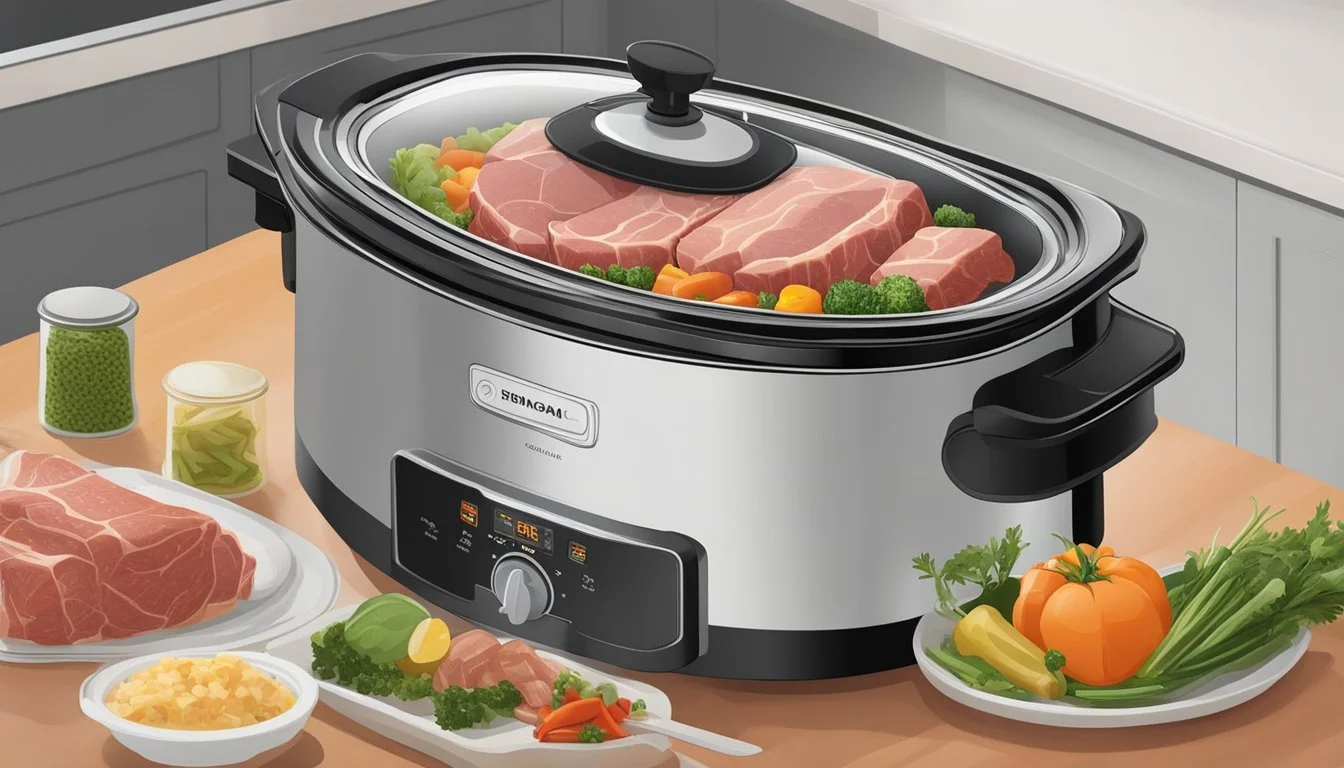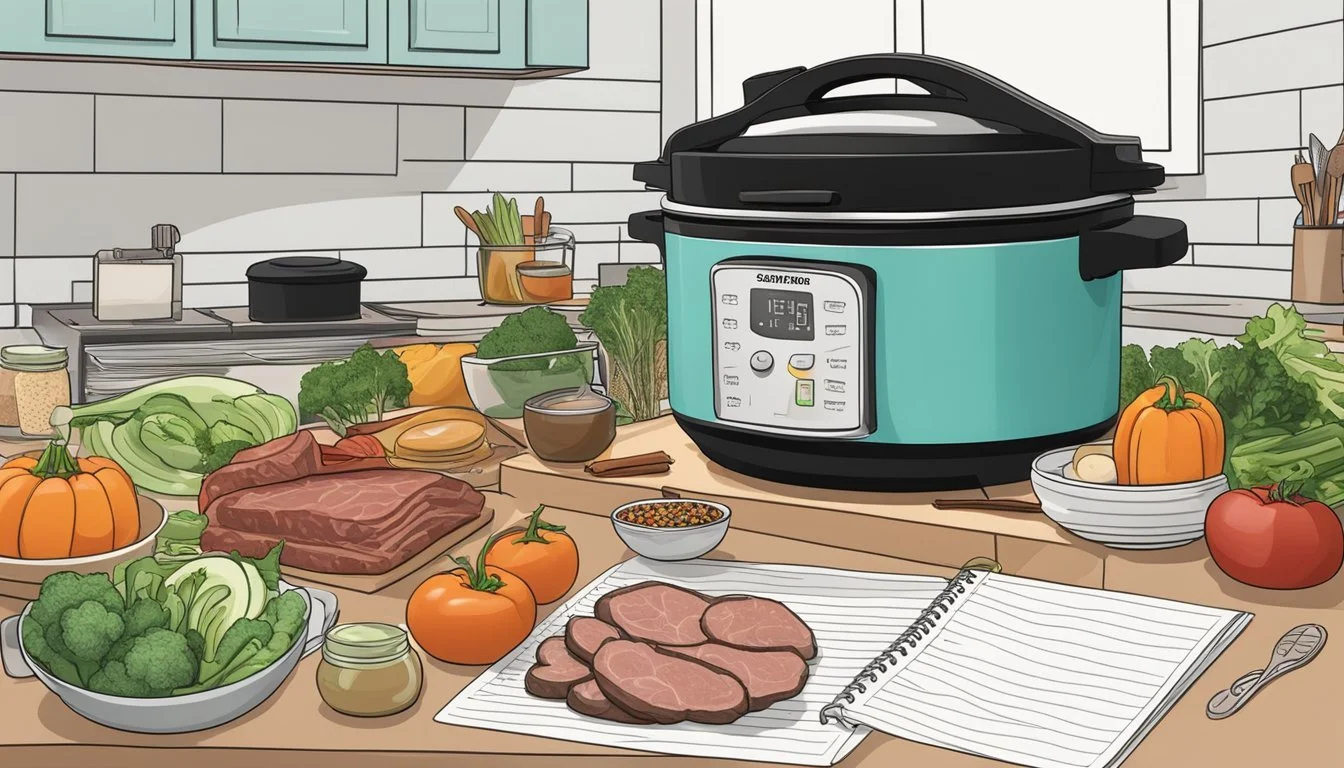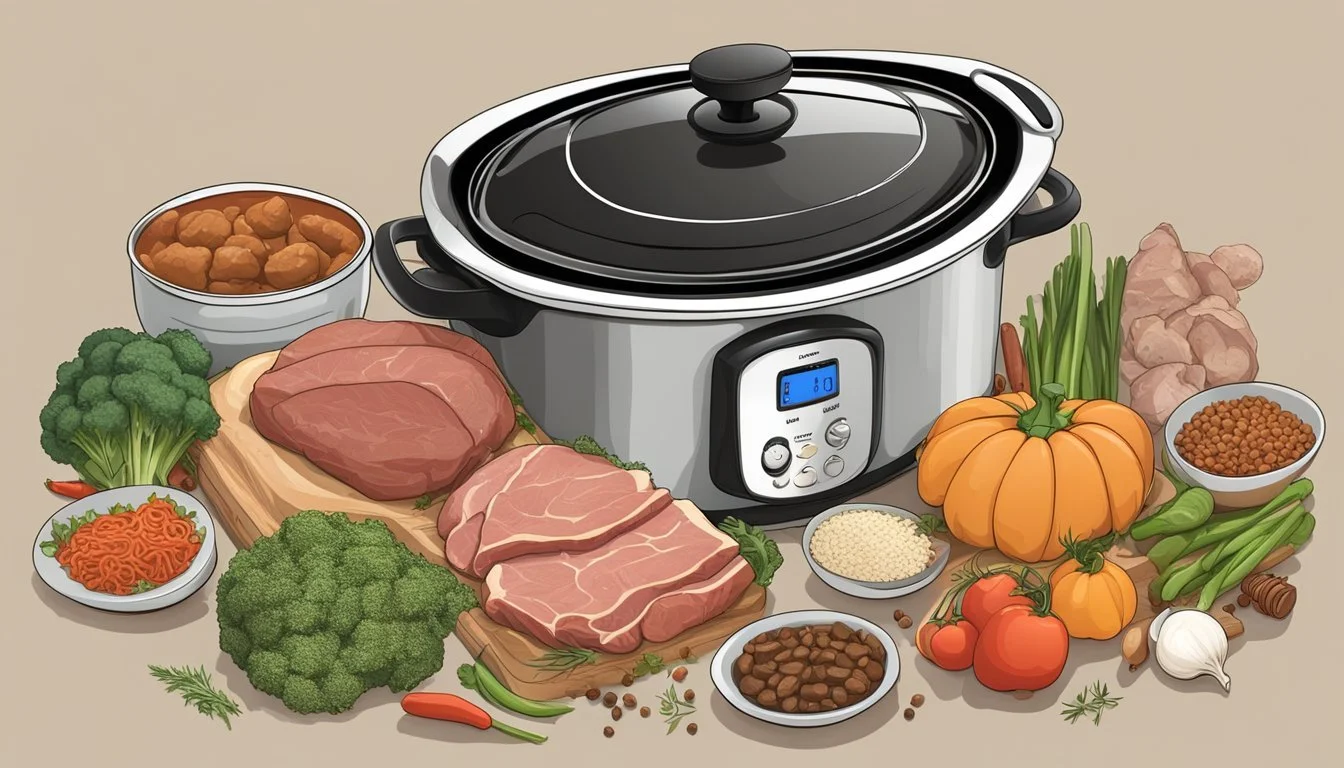How to Use a Slow Cooker for Easy Carnivore Diet Meals
Streamline Your Protein Prep
Slow cookers offer a convenient way to prepare nutritious meals with minimal effort. On the carnivore diet, which focuses strictly on animal products, a slow cooker can be a valuable tool for creating satisfying and tender meats. This method of cooking not only preserves the natural flavors and nutrients of the meat but also allows for a hands-off approach to meal preparation. Individuals following the carnivore diet can benefit from slow cooking as it allows them to batch cook and ensure they have a steady supply of high-protein, zero-carb meals throughout the week.
When using a slow cooker for the carnivore diet, the focus is on simplicity and food quality. Cuts of meat like chuck roast, beef (how long does beef last?) shank, and others that traditionally benefit from slow braising become the stars of the meal. The slow cooking process tenderizes these firmer cuts over several hours, leading to a flavorful and satisfying dining experience. Cooking in this manner also means there's no need for additional spices or ingredients that may not comply with the strict guidelines of the carnivore diet, as the slow cooker enhances the meat's natural taste.
Understanding the Carnivore Diet
The Carnivore Diet centers on consuming exclusively animal products and is characterized by a zero-carb nutritional approach. Now, let's break down the core principles and health advantages associated with this diet.
Fundamentals of a Carnivore Diet
The Carnivore Diet strictly revolves around the consumption of animal meat and animal foods such as:
Beef
Poultry
Fish
Eggs
Dairy (for some individuals)
This elimination diet removes carbohydrates, vegetables, fruits, and plant-based foods, focusing instead on high-quality protein and fat from animal sources. Nutrition on a Carnivore Diet is, thus, obtained from these proteins and fats, aiming for optimal health through a dietary framework that proponents argue is aligned with human ancestral eating patterns.
Benefits of Zero-Carb Living
Adherents of a zero-carb lifestyle, like the Carnivore Diet, often report a range of health benefits:
Weight Management: Due to the satiating effect of high-protein meals.
Simple Food Choices: The diet eliminates the need to count calories or carbs.
Potential Health Improvements: Some claim enhanced mental clarity and energy levels, as well as reduced inflammation markers.
It is important, however, for individuals to consult healthcare professionals before adopting such a restrictive diet to ensure it aligns with their health goals and nutritional needs.
Getting Started with Your Slow Cooker
Navigating the basics of slow cooking can transform how one prepares carnivore diet meals. Optimizing slow cooker use ensures tender, flavorful results with minimal effort.
Choosing the Right Slow Cooker
When selecting a slow cooker, size and settings are crucial. Sizes range from 1-7 quarts, with 3-4 quarts suitable for meals serving 2-4 individuals, and larger sizes fit for groups or meal prepping. Settings usually include low and high - the former is about 200°F, ideal for longer cooking, while the latter roughly 300°F suits shorter durations. A Warm setting keeps food at a safe temperature until ready to serve.
Slow Cooker Basics
To start, one should familiarize themselves with the fundamental process:
Prep Ingredients: Meat can be browned beforehand for added flavor, but it's not a requirement for all recipes.
Layer Wisely: Root vegetables take longer to cook, so they should go in first, at the bottom, closer to the heat source.
Fill Appropriately: Fill the crockpot to at least half but not more than three-quarters to ensure even cooking.
Add Liquid: While some moisture is generated during cooking, adding stock, water, or other liquids helps to distribute heat and prevents drying out.
Make your life easier by ordering crockpot online; it's just a few clicks away!
Safety Tips for Slow Cooking
Adhering to safety precautions is essential:
Do Not Overfill: To avoid spillage and ensure the food cooks evenly, never fill the slow cooker more than three-quarters full.
Keep the Lid On: Frequent removal of the lid causes heat loss and can significantly extend cooking time.
Safe Temperature: Use an instant-read thermometer to check that meat has reached a safe internal temperature before consumption.
By understanding their appliance's capabilities and limitations, individuals can confidently use their slow cooker to craft nutritious, carnivore-friendly meals with ease.
Avoid the crowds and shop for instant-read thermometer online from the comfort of your home!
Essential Ingredients for Carnivore Diet Meals
When preparing carnivore diet meals in a slow cooker, one should focus on high-quality meats, the right fats for cooking and flavor, and minimal seasonings that comply with the diet's strict framework.
Best Meat Selections
For the carnivore diet, choice cuts of meat are the cornerstone. Selecting a variety of meats ensures a broad spectrum of nutrients and flavors. The slow cooking process lends itself well to tougher, fattier cuts which become tender over long cooking periods. Beef shank and chuck roast are ideal due to their fat content and texture. Carnivore diet enthusiasts might also consider less traditional options like marrow bones that can be slow-cooked to a gelatinous consistency.
Fats and Oils to Use
Fat is a primary source of energy for those following the carnivore diet. As such, incorporating sufficient fat is crucial to the success of these meals. Tallow, rendered beef fat, is a preferred choice as it imparts rich flavor and is stable at high cooking temperatures. Another excellent option is to use bacon, which provides both fat and a savory taste to dishes. These fats should be used liberally to ensure meals are both satisfying and in line with dietary needs.
Experience the convenience and savings of buying tallow online!
Seasoning Meat for Carnivore Recipes
Seasonings are typically minimal on the carnivore diet, but certain herbs and spices can be used to enhance the natural flavors of the meat without adding non-animal products. Pure, unprocessed salt is an essential seasoning that can be used to taste for its ability to enhance flavor and tenderize the meat. For those who wish to incorporate herbs, options like rosemary and thyme can be used sparingly to add subtle notes without overpowering the meat's inherent taste.
Carnivore Diet Slow Cooker Recipes
Using a slow cooker simplifies meal preparation, especially for those following a carnivore diet, where the focus is on high-quality animal products. These recipes are designed to cater to this eating style with ease and flavor.
Carnivore Breakfast Ideas
Carnivore Beef Stew can be a warm and satisfying start to the day. For a single serving, one can brown a small portion of beef cubes, then transfer them to the slow cooker with a cut of beef shank. Add enough beef broth to cover the meat and cook on low for 8-10 hours. The result is a delicious and easy breakfast stew.
Hearty Carnivore Dinners
Crockpot Chuck Roast: Chuck roast is an excellent dinner choice for its fattiness and rich taste. After placing the chuck roast in the slow cooker, cook it on low for about 8 hours to achieve a fall-apart texture without the need for extra spices—perfect for a single serving or a family dinner.
One-Pot Carnivore Staples
Slow Cooker Shredded Chicken: Chicken, particularly when combined with bacon in the slow cooker, can create a tender, flavorful dish. Mix ingredients in a slow cooker and set to low for 8 hours. For a larger gathering, double the servings, ensuring the slow cooker is not overcrowded to maintain even cooking.
Creating Your Carnivore Meal Plan
When crafting a meal plan, consider incorporating Carnivore Pulled Pork as a versatile staple that can be used in various meals throughout the week. Season a pork shoulder with simple salt and place it in the slow cooker, pouring chicken broth over it. Cook on low for 7-9 hours until tender. This can provide multiple servings for use in dishes like a carnivore casserole or as a protein-rich standalone option.
Remember, when planning for meals, accounting for serving sizes and cooking times will keep the diet both manageable and nutritious.
Preparation and Cooking Techniques
When utilizing a slow cooker for the carnivore diet, the focus is on selecting quality meats and cooking them for optimal tenderness. Preparing meats properly and understanding cooking times are key to ensuring delicious, fork-tender results.
Prepping Meats for the Slow Cooker
Proper preparation of meats is essential for maximum flavor and texture. Trimming excess fat to a thickness of about 1/4 inch allows for a balance of flavor while cooking. Even though slow cookers can handle various cuts, trimming helps in even cooking. Before placing meat in the slow cooker, searing it on all sides in a pan forms a flavorful crust. This technique, although not mandatory, can significantly enhance the taste of the final dish.
Mastering Cooking Times
For a carnivore diet, slow cookers excel in breaking down tougher cuts of meat over time. The general rule is to cook on low for 8-10 hours or on high for 4-5 hours. However, thicker cuts or a full beef shank may need adjustment.
Low Temp: 8-10 hours, extendable to 12
High Temp: 4-5 hours, extendable to 6
It's pivotal to adjust times accordingly and refrain from lifting the lid frequently, as this can lengthen the cook time. The slow cooker should reach a point where the meat can be easily pulled apart with a fork, signifying it is fork-tender.
Tips for Achieving Tender Meat
The secret to fork-tender meat in a slow cooker is patience and minimal interference. Over time, the connective tissues within tougher cuts melt away, creating succulent and moist meat. To ensure uniform cooking and tenderness:
Layer the meat properly—start with larger cuts at the bottom.
Avoid overfilling the slow cooker; it should be no more than two-thirds full.
Salt the meat generously before cooking to enhance its natural flavors.
Rotate or flip meat halfway through cooking if the cut is uneven.
By adhering to these methods, the meat will gradually become tender and maintain its moisture, making every carnivore slow cooker meal an exemplary experience in both taste and texture.
Storing and Preserving Your Meals
Proper storage of slow cooker meals is crucial for maintaining freshness and preventing foodborne illnesses. The following strategies ensure one can enjoy their carnivore diet dishes safely over time.
Refrigeration and Freezing Strategies
Meals should be divided into single servings as soon as they cool to avoid bacterial growth. These servings can be placed in the fridge if they will be consumed within 3 to 4 days. For extended storage, the freezer is a suitable option. Use airtight containers or freezer bags to prevent freezer burn and preserve the quality of the meat. Label each container with the date to track how long they've been stored.
Refrigerator:
Cool down to room temperature.
Store in airtight containers for up to 3 to 4 days.
Divide into portions to avoid reheating excess food.
Freezer:
Freeze in airtight containers.
Can be stored for several months.
Thaw in the fridge overnight before reheating.
Online stores offer unbeatable prices for airtight containers, so don't miss out!
Safely Reheating Slow Cooker Meals
When reheating, one should ensure the meal is heated thoroughly to an internal temperature of 165°F. Meals can be reheated in a microwave or stovetop; however, one must ensure that the food is covered and stirred occasionally to avoid uneven heating. It's important to reheat only the amount needed for immediate consumption.
Microwave: Cover the meal. Heat in intervals, stirring in between.
Stovetop: Place in a pot with a little water or broth. Heat over medium, stirring frequently.
Advanced Topics
In the realm of the carnivore diet, enthusiasts can elevate their slow cooker creations by focusing on ingredient variety and exploring unconventional cuts of meat. These enhancements allow for culinary diversity without deviating from zero-carb principles.
Mixing and Matching Zero-Fiber Ingredients
The carnivore diet eschews fiber, so when one uses a slow cooker, it's essential to select zero-fiber ingredients that complement each other. Traditional vegetable additions are omitted, but this presents an opportunity to get creative with animal-based products:
Fats: Add variations of animal fat to enrich flavor.
Dairy: Incorporating dairy like butter or hard cheeses can add depth to dishes, provided tolerance is established.
Eggs: Eggs can be used to thicken sauces, bring substance, or add a different texture.
To ensure meals remain interesting and enjoyable, one might experiment with combinations like pork belly with a touch of hard cheese or beef cuts slow-cooked in butter.
Experimenting with Rare Meat Cuts
Adventurous cooks on the carnivore diet can utilize the slow cooker to tenderize and savor less-common cuts of meat that are often overlooked:
Beef Shank: Usually requires extensive cooking time to become tender.
Chicken Hearts: These can provide a unique flavor and texture profile, better enjoyed when slow cooked.
Liver: An organ meat packed with nutrients that requires careful cooking to make it palatable.
These rare cuts are not only cost-effective options but also provide a variety of essential nutrients, promoting nose-to-tail eating, which is encouraged within the carnivore community. A slow cooker makes these tougher, unusual cuts succulent and enjoyable with minimal effort.
Shopping and Budget Tips
Incorporating a carnivore diet into one’s lifestyle using a slow cooker can be both cost-effective and convenient. By developing a targeted shopping list and identifying budget-friendly meat sources, adherents can enjoy the richness of carnivore meals without overspending.
Creating a Smart Carnivore Shopping List
A prioritized shopping list ensures that only essential, carnivore-approved items are purchased. Essentials typically include high-fat cuts for slow cooking, such as chuck roast, lamb, and ground beef. Shoppers should list meats by priority while considering sale items or bulk discounts. For example, chuck roast is both cost-effective and excellent for slow cooking, making it a top item on the list. White Oak Pastures is one example where quality meats can be sourced, supporting responsible agriculture practices.
Finding Affordable Meat Options
To keep meals affordable, one must look for meat vendors that offer competitive pricing without compromising on quality. Local butchers or farmers' markets often provide better deals, especially when purchasing in bulk. Supermarkets may also offer discounted prices for larger cuts like lamb or ground beef that can be used across multiple meals. Buying larger cuts and using every part is both economical and in line with carnivore principles.
Look for sales or clearance items, especially for cuts suitable for slow cooking like lamb shoulder or leg.
Consider subscribing to meat delivery services that focus on carnivore foods, which can offer savings over time.
By diligently following these tips, individuals can manage a budget-friendly and satisfying carnivore diet using their slow cooker.
Nutritional Information and Health Implications
When using a slow cooker for carnivore diet meals, understanding the nutritional content is essential for maintaining health. This includes the balance of macronutrients and the implications of consuming a high-protein, zero-carb diet.
Analyzing Carnivore Diet Macronutrients
The carnivore diet focuses on consumption of animal products, emphasizing a high intake of protein and fat, with a complete elimination of carbohydrates. A slow cooker can be used to prepare meats which are nutrient-dense and rich in essentials like B vitamins, minerals, and saturated fats. For instance, a typical portion of cooked beef may provide approximately 300 calories, with about 20 grams of protein and 15 grams of fat.
Health Considerations
While the carnivore diet may offer nutritionally dense options rich in protein and necessary fats, it also raises health considerations due to its high levels of saturated fat and lack of dietary fiber. Individuals should be aware of their specific health needs, particularly regarding heart health and cholesterol levels, when consuming a diet high in animal products. Although the diet is nutritious in terms of essential vitamins and minerals, the absence of fruits, vegetables, and whole grains might require a strategic approach to prevent potential nutrient deficiencies.
Additional Variations and Diet Blending
In pursuit of optimal health and weight management, one can blend the carnivore diet with other dietary strategies such as the ketogenic diet and intermittent fasting. These approaches can be complementary and may enhance the benefits of a meat-focused nutrition plan when using a slow cooker.
Carnivore Diet Meets Keto
The carnivore diet can easily align with the ketogenic diet as both emphasize low carbohydrate intake. When preparing slow cooker meals for a carnivore-keto blend, it is crucial to focus on high-fat cuts of meat and to ensure that additional ingredients maintain the necessary macronutrient ratios.
Optimal Fat-to-Protein Ratios for Ketosis: Aim for fattier meat cuts such as ribeye steaks (What wine goes well with ribeye steak?), beef brisket, (What wine goes well with beef brisket?) or pork shoulder. Adding butter or ghee can further increase fat content.
Examples of Carnivore-Keto Slow Cooker Meals:
Beef Stew: Use beef shank and fatty stew meat, optional bone broth, and cook on low for up to 12 hours.
Pulled Pork: Season a pork shoulder with salt and cook until it can be easily shredded.
Incorporating Intermittent Fasting
Intermittent fasting involves cycling between periods of eating and fasting, which may accelerate fat loss and improve metabolic health. A slow cooker can be particularly useful for someone on a carnivore diet practicing intermittent fasting, as it allows for the preparation of large, nutrient-dense meals that can satisfy for extended periods.
Meal Timing: It's practical to time slow cooker meals to be ready at the end of a fasting window, providing one substantial meal to break the fast.
Meal Examples for Break-Fast:
Large Carnivore Omelette: Cook a mixture of eggs and shredded meats in a slow cooker on high for 1-2 hours.
Carnivore Pot Roast: Place a well-seasoned roast into the slow cooker and set it to be ready just in time to break the fast.
Using a slow cooker aligns with the preparatory needs of both the carnivore and keto diets and fits into the eating schedule of intermittent fasting without compromising the dietary guidelines of either nutrition plan.
Troubleshooting Common Issues
When crafting delicious carnivore diet meals with a slow cooker, users can encounter a variety of issues affecting taste and texture. This section provides practical solutions to common problems ensuring that meals remain easy to prepare with minimal prep work.
Adjusting Flavors Without Plant Ingredients
Problem: The meal tastes bland.
Solution: Since traditional flavor enhancers like herbs and spices are often off-limits on a carnivore diet, one may boost flavor by searing meats before adding them to the slow cooker. A quick sear provides a rich, caramelized crust, adding depth to the dish.
Problem: The dish is monotonous.
Solution: Experiment with different cuts of meat – including fattier options like chuck roast – to vary flavor and texture, since each cut has a distinct taste.
Dealing with Cooking Challenges
Problem: Meat is too dry or tough.
Solution: Use cuts of meat suitable for slow cooking like beef shank or brisket that benefit from long, slow cooking times to become tender.
High Cooking Temp: If a cut turns out tough, it may have cooked at too high a temperature, or for too short a time.
Low Cooking Temp: Conversely, if the meat is too tender and falling apart excessively, using a lower temperature setting for a longer period may be necessary.
Problem: Excess liquid in the dish.
Solution: Carnivore diet meals in a slow cooker require less liquid because there's minimal evaporation. If the dish is too watery, removing the lid and setting the slow cooker to high for the last hour can help reduce liquid.
Problem: Cleaning difficulties.
Solution: After the slow cooker cools, dismantle the removable parts and clean them with warm, soapy water. For tough stains, a paste of baking soda and water can be gently applied, ensuring pieces are dry before reassembly.
Conclusion
Utilizing a slow cooker for the carnivore diet streamlines meal preparation, ensures tender results, and retains the nutritious value of meats. Chuck roast and beef stew have been highlighted as delectable options that benefit from the slow cooking method. Meals prepared in a slow cooker on the carnivore diet should focus on:
Simplicity: Just meat, with perhaps a touch of salt, allowing the natural flavors to shine.
Patience: Slow cooking typically ranges from 4 to 12 hours, creating fork-tender textures.
Variability: Different cuts of meat can be experimented with, such as ground beef or chicken, to add variety to the diet.
Before concluding, it is essential to underscore that the individual's adherence to dietary choices should be respected and they should consult health professionals if needed.
For the committed to the carnivore diet, incorporating slow cooker recipes is a beneficial strategy. It ensures meals are both satisfying and conveniently prepared while maintaining the dietary framework. Whether one opts for a hearty stew or a classic roast, the slow cooker remains an invaluable ally in the carnivore kitchen.













